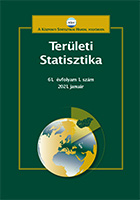A kulturális és kreatív ipar társas vállalkozásainak
teljesítménye a magyar nagyvárosokban, 2008–2018
The performance of the enterprises in the cultural and creative industries in the Hungarian big cities between 2008 and 2018
Author(s): Petra Kinga Kézai, János RechnitzerSubject(s): Social Sciences, Economy, Geography, Regional studies
Published by: Központi Statisztikai Hivatal
Keywords: cultural and creative economy; urban research; urban development
Summary/Abstract: The creative economy is increasingly becoming more and more important within national economies. The present study aims to examine the performance of partnerships belonging to the creative industrial branches in Hungary between 2008 and 2018. There search questions: What economical potential does creative economy represent in Hungary and in certain large cities? What tendencies do show its temporal changes? What are the professional branches in cities that defy creative economy, and how has their performance changed in the period examined in this study? This analysis deals with partnerships in creative economy present in Budapest, and the 8 cities of Hungary with a population larger than 100 thousand. The statistical analysis is based on the database of Dun&Bradstreet Hungary Kft. The data of companies operating on the last day of the given year were collected based on the valid Unified Sectoral Classification System (TEÁOR) codes and according to the indicated registered office, thus guaranteeing the full national coverage. In the case of headcount data, only reports for the entire calendar year were included in the study based on the statistical headcount for the given year. Research has shown that in the 11-year scope of the study, there were no significant territorial changes in creative economy, Budapest still dominates the landscape, the other 8 cities play minor roles with 11–12 percent according to all organisations. The cities have all had their own development paths in the period studied.
Journal: Területi Statisztika
- Issue Year: 62/2022
- Issue No: 02
- Page Range: 218-248
- Page Count: 31
- Language: Hungarian

